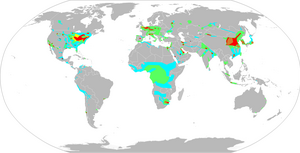 |
| English: A schematic of the global air pollution. The map was made by User:KVDP using the GIMP. It was based on the global air pollution map by the ESA (see http://www.esa.int/esaEO/SEM340NKPZD_index_0.html , http://esamultimedia.esa.int/images/EarthObservation/pollution_global_hires.jpg ) (Photo credit: Wikipedia) |
Air Pollution Increases Heart Attacks(Science Daily, Oct. 7, 2013)
Also quoted here: Air pollution increases heart attacks (Oct. 7, 2013 European Society of Cardiology)
Today we review research into the health impacts of higher levels of particulate matter on the acute cardiovascular events. The author concludes that the EU threshold of 50 micrograms/m3 needs to be lower, underlining that there is no absolutely safe level when it comes to fine particulates and the heart. Also those over 65 years old are particularly affected so that with the doubling of older segment of society in many countries, this research becomes more important than ever.
Key Quotes:
"Some studies conducted in Europe and the US have reported an association between air pollution, especially fine and ultrafine particles which are measured as particulate matter (PM) 10, and not only respiratory disease but also acute cardiovascular events and deaths. The European Union has set a PM10 safety threshold of 50 micrograms/m3 but the negative effect of PM10 on the cardiovascular system may occur at levels lower than this cut off."
Findings:
“ a significant association between PM10 levels and admission for acute cardiovascular events such as acute coronary syndromes, heart failure, worsening heart failure, paroxysmal atrial fibrillation and ventricular arrhythmias. The effect was linear, with a 3% increase in admissions for every 10 microgram increase in PM10.”
“that older people (>65 years) and men were particularly susceptible to having arrhythmias, atrial fibrillation or acute coronary syndromes at increasing levels of air pollution.”
"This may be related to a higher prevalence of comorbidities and greater fragility of the cardiovascular and circulatory system associated with aging."
"Previous studies support the hypothesis that air pollution may increase cardiovascular event rates because PM10 can induce processes that are bad for the heart including inflammation and coagulation."
"The current PM10 threshold of 50 micrograms/m3 is too high because at this level we observed an increase in hospitalisations for heart diseases. The cut off should be reduced to 20 -- 30 micrograms/m3, or even less if possible”


























































